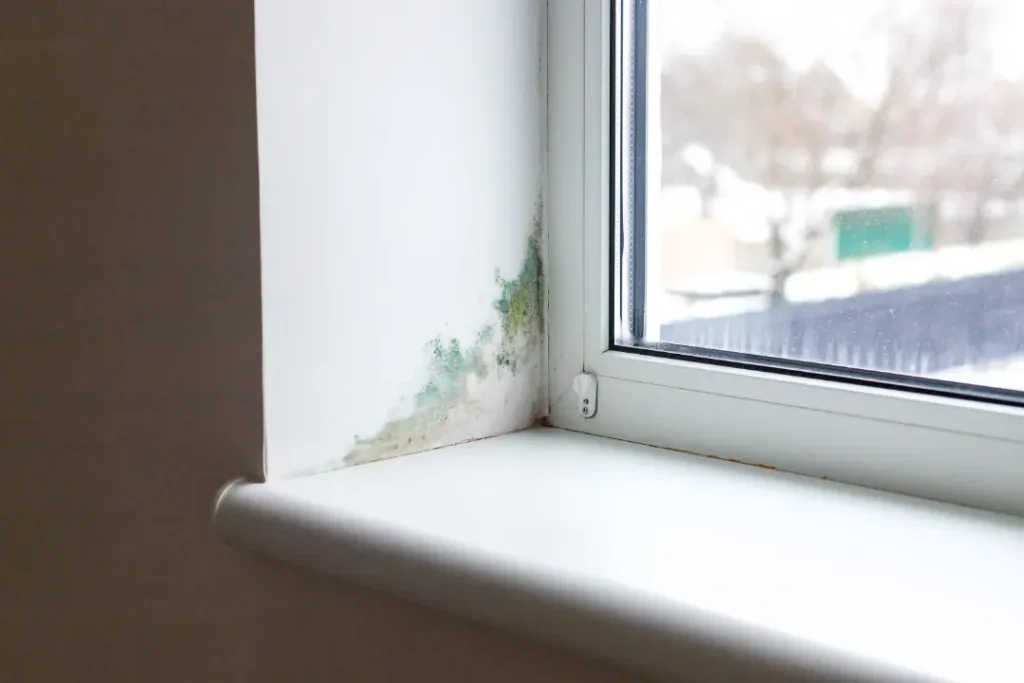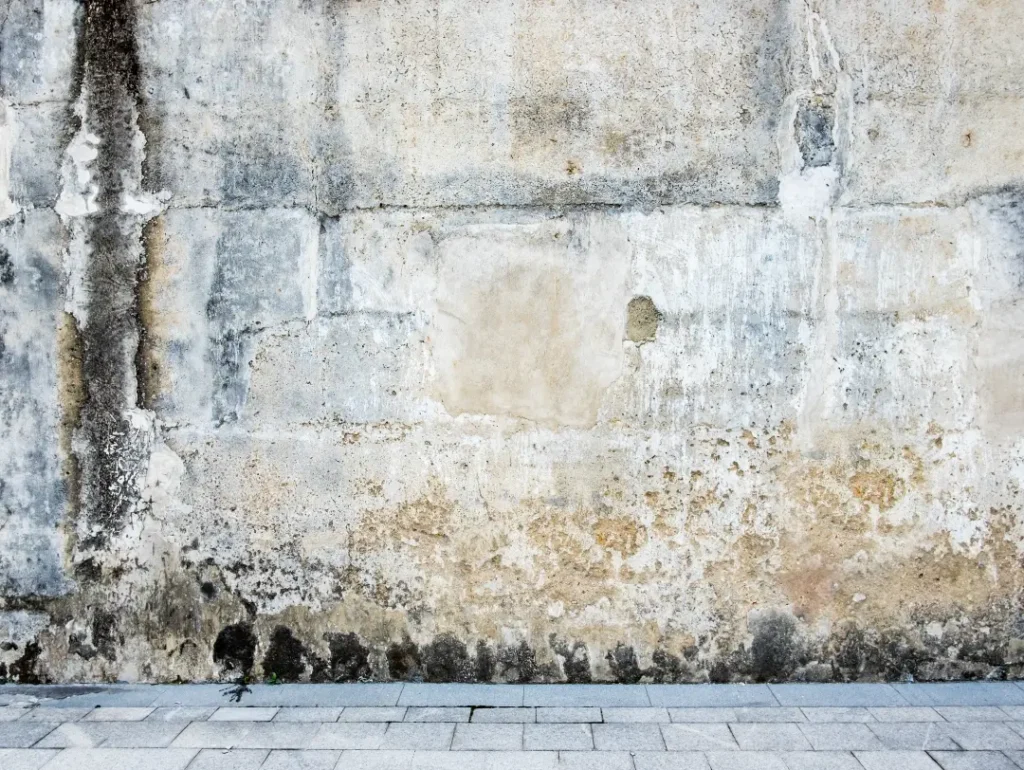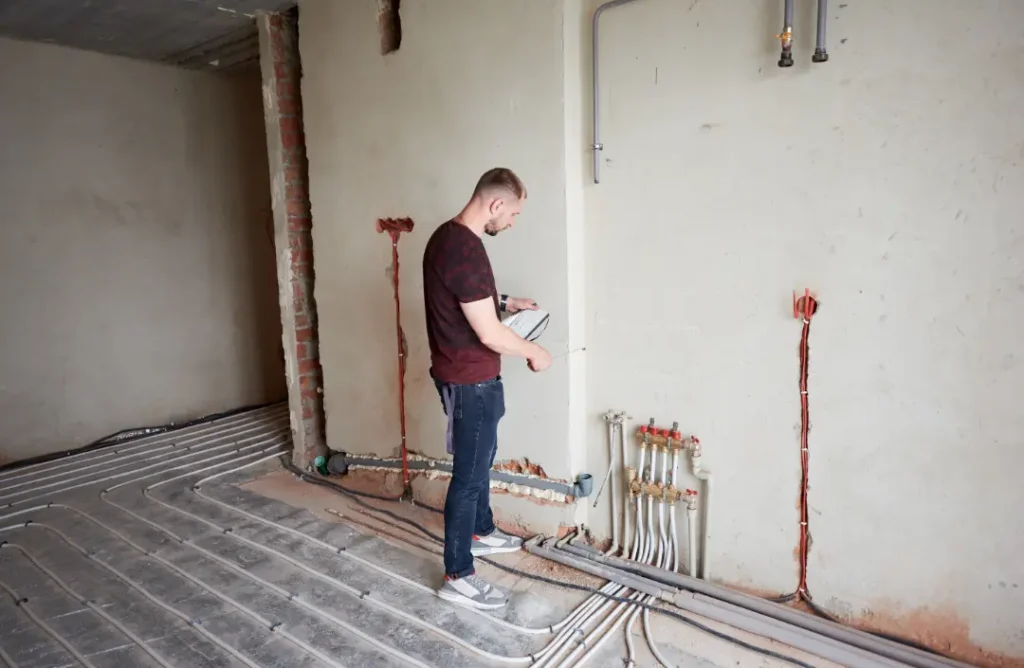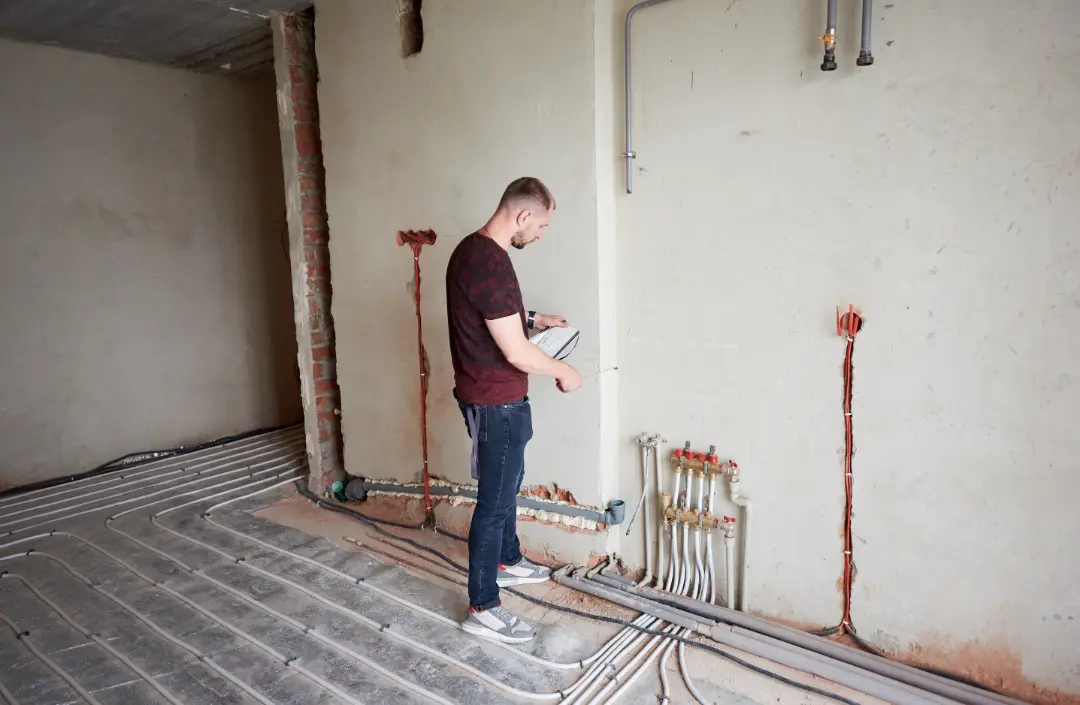How does damp affect the structural integrity of a building? Damp can infiltrate walls, floors, and ceilings, leading to deterioration and weakening.
This article examines rising damp, penetrating damp, and condensation, explaining how each type contributes to structural damage and what you can do to prevent it.
Key Takeaways
- Damp in buildings results from excess moisture, leading to structural integrity issues and health risks like mold growth.
- There are three main types of damp: rising damp, penetrating damp, and condensation. Each requires specific identification and treatment strategies.
- Regular maintenance, inspections, and effective damp-proofing measures prevent moisture-related damage and ensure long-term building durability.
Understanding Damp in Buildings
Damp in buildings is the presence of excess moisture within building materials or the surrounding air. This excess moisture can lead to significant structural integrity issues over time. Additionally, damp environments can promote the growth of mould and mildew, which pose health risks such as respiratory problems and allergic reactions.
Ignoring damp issues can worsen these problems, making early identification and prompt action essential. By understanding the causes and types of damp, we can develop effective, long-term solutions that prevent recurrence and help maintain the durability and safety of buildings.

What is Damp?
Damp is unwanted moisture in a building. It often comes from ground moisture, leaky roofs, or walls that let rain in. There are different types of damp: rising damp, penetrating damp, and structural damp. Each type needs a specific approach to fix it.
Finding the root cause is key. This helps in applying the right damp proofing treatments. Using the wrong methods can make structural issues worse.
Types of Damp
Damp issues typically fall into three main categories: rising damp, penetrating damp, and condensation. Rising dampness is often identified by tide marks and staining on walls, usually in older properties without a damp-proof course.
Penetrating damp, conversely, is characterised by isolated damp patches on walls, ceilings, or floors, often due to water ingress points like leaking roofs or gutters.
Lastly, condensation is marked by water droplets on surfaces, mould growth, and peeling wallpaper, commonly seen in areas with poor ventilation.
Rising Damp and Structural Integrity
Rising dampness poses a serious problem for buildings. It can result in considerable structural damage over time. This type of damp occurs when groundwater rises through porous materials like bricks and stones via capillary action, typically affecting ground-floor areas.
Moisture build-up from rising dampness can compromise the structural integrity of building materials such as timber and plaster, leading to deterioration and weakening of the structure. Addressing the root causes and implementing effective damp proofing measures prevents long-term damage.
Causes of Rising Damp
Rising damp happens when groundwater rises through porous materials like brick and stone. This occurs due to capillary action. You can often spot it by tide marks on walls.
Common causes include:
- Inadequate damp-proof courses
- Plumbing issues
- Blocked gutters
- Leaking roofs
Rising damp is especially common in ground-floor areas. It’s crucial to maintain effective damp-proof courses (DPC) to prevent this issue.
Effects on Building Materials
Rising damp can severely affect building materials, leading to crumbling plaster, wood rot, and overall structural damage. This can significantly weaken the building’s integrity and make it unsafe.
Additionally, interstitial condensation—where moisture is trapped within the building fabric—can cause hidden structural damage before it becomes visible. Promptly addressing both rising damp and condensation issues is necessary to protect the longevity and safety of building materials.
How to Prevent Rising Damp
Preventing rising damp involves several strategies, including maintaining lower external ground levels compared to internal floors and installing remedial damp-proof courses (DPC). Chemical DPC injections can form effective horizontal barriers against moisture ingress.
Identifying the type of damp affecting a building is necessary, as different types require specific treatments to ensure long-term protection.
Penetrating Damp and Its Consequences
Penetrating damp caused by external moisture entering a building poses significant threats to structural integrity. It leads to the deterioration of crucial elements such as walls, timber, and masonry, thereby compromising the building’s safety and durability.
Promptly addressing penetrating damp prevents extensive structural damage and costly repairs.

Sources of Penetrating Damp
Penetrating damp occurs when moisture infiltrates structural components like walls and ceilings due to deficiencies such as inadequate roof coverings, cracked render, leaking gutters, and damaged pipes. Properly sealing windows and doors prevents water ingress and avoids structural issues associated with penetrating damp.
Impact on Structural Elements
Penetrating damp can extensively impact structural elements, causing rotting timber, weakened rafters, and decaying brickwork. Spalling, visible watermarks, and plaster damage also compromise structural integrity.
Penetrating damp also promotes mould and mildew growth, further deteriorating building materials and posing health risks.
Repair and Prevention Strategies
Repairing and preventing penetrating damp requires addressing external faults such as masonry, cracks, and loose mortar joints. Proper drainage and installing physical damp-proof courses during construction or major renovations can effectively prevent moisture ingress.
Condensation and Structural Damage
Condensation, a common source of damp, can lead to significant structural damage when moisture penetrates building materials. It often occurs in high-humidity areas like kitchens and bathrooms, where excess moisture condenses on cold surfaces.
Over time, condensation can cause timber decay, plaster deterioration, and mould growth, all of which weaken structural integrity.
Formation of Condensation
Condensation occurs when moist air meets cooler surfaces, forming water droplets. This process is common in kitchens, bathrooms, and poorly ventilated areas where activities like cooking and showering raise humidity levels.
Interstitial condensation, where moist air and warm air get trapped in enclosed spaces like walls or roofs, can cause hidden damage that may not be immediately visible.
Structural Impacts
Prolonged exposure to condensation can cause structural damage. This includes the deterioration of plaster and paint. It can also lead to mould growth. Continuous moisture weakens building materials, affecting the building’s structural integrity.
When moisture damage is combined with mould, it can compromise safety and durability. That’s why early intervention is crucial.
Mitigation Techniques
Mitigating condensation involves improving ventilation to reduce humidity levels and prevent moisture build-up. Dehumidifiers and fans help control indoor humidity, while mould-resistant paint prevents mould growth in susceptible areas.
Lifestyle changes, such as drying clothes outdoors and covering pans while cooking, can significantly reduce indoor moisture levels, maintaining a healthier living environment.
Choose Environ Property Services Damp Proofing to Protect Your Home with Expert Damp Solutions
At Environ Property Services, we understand the weight of damp issues and how they can impact your home. Our dedicated team of specialists is committed to providing you with the best damp-proofing solutions, safeguarding your property from rising damp, penetrating damp, and condensation. We believe that every home deserves to be a safe and healthy environment, and we are here to help you reclaim yours.
We take pride in our personalised approach, tailoring our treatments to meet your specific needs. Our thorough surveys ensure we accurately identify the type of damp affecting your property, allowing us to implement effective solutions that provide long-lasting results.
We Are Your Trusted Specialists for Period Properties
Handling damp issues in period properties and historic structures requires a unique understanding and skill set. At Environ Property Services, our team excels in preserving the integrity of older buildings while effectively managing damp problems. We recognise the importance of maintaining the heritage and character of your home, and we approach every project with the utmost care and respect. By integrating traditional craftsmanship with modern technology, we deliver effective and durable damp-proofing solutions that respect the original architecture and materials.

Our extensive experience in treating historic properties means we can navigate the complexities of damp issues without compromising the charm and authenticity of your space. We are dedicated to ensuring that your beloved home remains structurally sound and beautifully intact for generations to come.
Why Choose Environ Property Services?
Choosing Environ Property Services means opting for peace of mind. You can trust us to tackle any damp-related issue with professionalism and empathy, ensuring that your home is treated like our own.
With a strong reputation earned from satisfied clients, we are recognised as the best damp proofing specailist in London. We guarantee our work and offer insurance coverage, allowing you to feel secure in your investment. Rest assured, with our expertise, your property is in capable hands. Let us help you protect your home and provide a healthy living environment for you and your family.
Maintenance and Long-Term Care for Damp Proofing
Effective maintenance is crucial for ensuring that damp proofing systems continue to perform well over time. Regular upkeep not only prevents moisture-related problems but also supports a building’s overall health and longevity.
Key Components of Damp Proofing Maintenance
Breathable Waterproofing Treatment: These applications allow moisture to escape while preventing water from entering, which is essential for protecting structural elements from damage.
Vapour Barriers: Installing vapour barriers helps to control moisture levels within walls, ceilings, and floors, shielding materials from potential dampness.
Proper Insulation: Effective insulation reduces temperature fluctuations, which can contribute to condensation. This helps to maintain a stable indoor environment and mitigates moisture buildup. Incorporating these elements into a damp proofing strategy enables property owners to maintain a healthier living environment and safeguard their investments.
Importance of Regular Inspections
Conducting regular inspections is vital for the early detection of potential damp issues. By identifying early signs of dampness, property owners can minimise damage and avoid costly repairs. Periodic assessments should be thorough, evaluating existing damp proofing systems to ensure they continue to meet evolving building conditions and standards.
Enhancing Ventilation and Moisture Control
Proper ventilation is an essential part of moisture control. Ensuring adequate airflow within a building can significantly lower indoor humidity levels, effectively preventing condensation and reducing the risk of associated respiratory issues. Implementing enhanced ventilation techniques, utilising moisture meters, and maintaining consistent indoor temperatures can greatly improve indoor air quality, leading to a healthier living space.
Updating Damp Proofing Measures
Regularly updating and maintaining damp proofing measures is critical to preventing moisture-related issues and protecting the structural integrity of a building. Inspections not only aid in the early identification of damp problems but also confirm that existing damp proofing systems are functioning effectively over time. It’s essential to adopt tailored damp proofing solutions that cater to the unique needs of different buildings. This proactive approach is fundamental for ensuring long-term protection against dampness and maintaining a safe, comfortable environment for occupants.
Frequently Asked Questions
What are the main types of dampness that can affect buildings?
Rising damp, penetrating damp, and condensation are the main types of damp that can affect buildings. Each type has distinct causes and requires tailored treatment approaches.
How can rising damp be prevented?
To prevent rising damp, ensure that external ground levels are lower than internal floors, and consider installing a damp proof course (DPC) or using chemical DPC injections such as Dryzone Damp-Proofing Cream. These measures effectively mitigate moisture intrusion.
What causes penetrating damp?
Penetrating damp is primarily caused by moisture entering through structural defects in walls and ceilings, including issues like inadequate roof coverings, cracked renderings, leaking gutters, and damaged pipes. Addressing these structural deficiencies is essential to prevent further moisture infiltration.
How does condensation form in buildings?
Condensation occurs when warm, moist air encounters cooler surfaces, leading to the formation of water droplets. This typically happens in high-humidity areas like kitchens and bathrooms, especially when ventilation is inadequate.
Conclusion
Understanding how dampness affects building structural integrity is crucial for property maintenance and occupant health. Rising damp, penetrating damp, and condensation each pose unique challenges and require specific solutions to mitigate their effects. By identifying the causes and taking preventative measures, we can protect our buildings from significant structural damage and maintain their durability over time.
Professional services like Environ Property Services play a vital role in diagnosing and treating damp issues. Our comprehensive damp surveys, tailored restoration solutions, and integration of traditional skills with modern technology ensure effective and long-lasting damp proofing. By staying vigilant and proactive, you can ensure a healthier living environment and preserve the structural integrity of your buildings.

